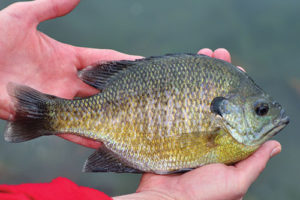Fish Stocking
Bluegill – Lepomis macrochirus
- Probably the most common fish found in private ponds in the State of Ohio. Bluegill grow relatively fast, readily bite baited hooks, and taste delicious – all qualities that make this a must-have fish for any pond owner. Their ability to reproduce rapidly can result in populations surpassing the carrying capacity of the body of water which can cause fish to become stunted. Regular harvest of several bluegill each year is recommended to maintain a healthy population.
- For newly constructed ponds, a stocking rate of 500 bluegill fingerlings per surface acre is the general guideline. To supplement existing populations, add 50-100 per year as needed.
Largemouth Bass – Micropterus salmoides
- If bluegill are the most common pond fish, then largemouth bass are next in line. Often considered the most popular freshwater sport fish, largemouth bass grow larger than other members of the sunfish family, and often serve as top predator in many pond and lake ecosystems. Largemouth bass are quite useful to help keep bluegill populations manageable, and provide good table fare themselves.
- Typical stocking rates for largemouth bass are 100/acre in new ponds, and as needed to supplement harvest and natural mortality in existing ponds.
Channel Catfish – Ictalurus punctatus
- Another species commonly found in Ohio ponds and lakes, channel catfish are renowned for their firm, mild flesh. Commercially raised for restaurants and wholesale food markets, channel catfish can also provide unique angling opportunities when stocked in private ponds. One of the few fish families that actively feed at night, catfish create an after-hours fishing option for anglers who want to avoid the heat of a mid-summer day.
- Stocking rates for channel catfish mirror those of largemouth bass with a 100/acre ratio recommended. **Note: channel catfish typically do not reproduce in small ponds (<5 acre), so supplemental stocking will be necessary to offset any harvest or natural mortality.
White Amur (grass carp) – Ctenopharyngodon idella
- A non-native fish introduced from Asia, the white amur, commonly called grass carp, is often stocked in low numbers in ponds as a method of biological control for aquatic vegetation. These timid herbivores often become the largest fish in a pond and can reach sizes of 40+” , but lose their effectiveness as vegetation managers as they approach full size and must be removed and young amurs (8-14”) restocked in their place.
- Stocking rates for white amurs are dependent on the amount of vegetation present in a pond, but generally run 4-10 per acre. **Note: white amurs offer a degree of aquatic vegetation control, but are not a universal cure to all pond weed issues. Used in conjunction with an integrated weed management program, they can prove to be a valuable tool however.
Other Species Occasionally Stocked
- Hybrid sunfish – A hybrid of bluegill and green sunfish, this fish is commonly stocked in conjunction with bluegill and largemouth bass. Hybrid sunfish grow faster and are more aggressive than bluegill and offer an angler-friendly option without danger of overpopulation.
- Redear sunfish – A sunfish species native to the southern United States, this fish is similar to bluegill in size and behavior, and can be stocked in lieu of, or in conjunction with bluegill. Redear sunfish are also known as “shellcrackers” due to their preference for eating snails and other small mollusks. Redear sunfish have been used successfully to control unwanted populations of snails that have taken over a pond.
- Crappie – Both species of crappie (black and white) are occasionally stocked in private ponds. Crappies are highly predatory and can consume large quantities of young bluegill and bass, so care should be taken if adding crappie to existing populations of these species. Crappie are excellent table fare, and can grow quite large (>15”) in a pond environment, so stocking them can be desirable if managed properly.
- Yellow perch – Traditionally considered a fish found mainly in large lakes and reservoirs, yellow perch can do well in small ponds if certain conditions are met. Yellow perch prefer cooler waters, so spring-fed or very deep ponds offer the best chance for success of this species. Commercially valued for their flesh, yellow perch offer a tasty treat for your pond.
***Species to Avoid***
- Rainbow trout – Will die if water temperatures exceed the mid 70’s, only suitable for “put and take” fisheries where annual survival is not expected.
- Common carp & Koi/Goldfish – While some people may appreciate the beauty of koi, the bottom feeding habits of these species can stir up sediment creating permanently turbid water and decreasing dissolved oxygen levels.
For a list of licensed Ohio fish propagators click here.

